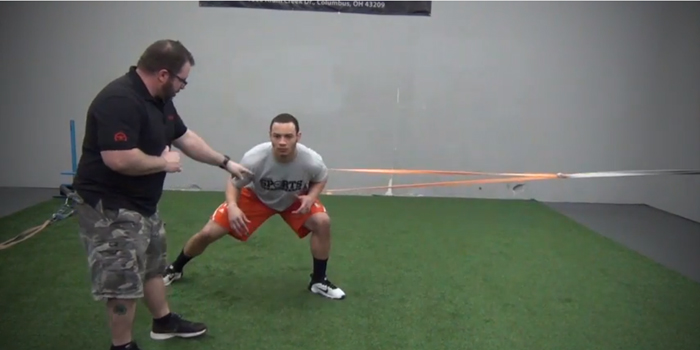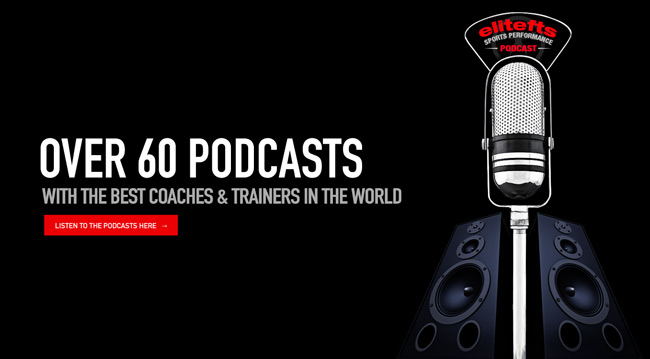
One of the biggest mistakes coaches can make is attempting to develop skills that may or may not translate to enhance sports mastery or athletic development. Training athletic ability in the weightroom is always debatable. Most of us understand the difference between athletic ability and specific sports skills. Two of these basic components of athletic development are sometimes addressed during training. But, are we really improving these skills at the rate and level needed to really make a difference on the field or court?
Two skills we will look at are:
- Reaction Time
- Balance
Reaction Time
Skills like visual acuity and reaction time are essential for success in sports. Being able to move explosively based on a visual or audible stimulus is a skill that can be trained. Or can it?
After reading and listening to The Sports Gene by David Epstein via an audiobook, I firmly believe the content is fascinating. Combining this book with Daniel Coyle's Talent Code, you can really gain a good grasp on what really makes an athlete an elite level athlete. The premise of Epstein's book is to explore the balance between genetics and hard work in developing skill and talent. It's the nature vs nurture debate as it relates to athletics. Epstein's analogy of "hardware" and "software" makes a ton of sense to me. We are all born with the same hardware or operating system (genetics) and we download software (practice and experiences) throughout our lives. More importantly, if we are born with better hardware, our software will be utilized more efficiently.
One of the first things Epstein talked about was reaction time as being one of the most desirable skills to train in athletes. He mentioned research that explains that all people, regardless of profession or genetics that almost all people's reaction time is right around 1/5 of a second. So why can't I a hit a 90mph fastball or return a tennis serve? Because major league baseball players or professional tennis players aren't relying on reaction time to hit a pitch or return a serve. They are using anticipatory visual cues to swing the bat or racket.
Basically, by the time a batter realizes the ball leaves the pitchers hand, the ball is already half-way to the plate. Batters use their relative experiences with the pitcher's body movements, arm trajectory, and other cues to anticipate whether they are going to swing the bat or not.
Epstein also discussed the research of Janet Starkes and Addriane deGroot. They were using visual representations of volleyball stills and chess boards respectively. Their studies were decades apart and with different sports but the concepts were the same. When shown action shots of a volleyball match, the better players were able to anticipate where the ball was being hit based on formations, body language etc. These pictures were displayed for less than second to the subjects. Same goes for the random chess boards flashed in from of players or various skill levels. The better the player, the more accurately they could recreate the board. That is unless the board was configured in a way that could not possibly happen in a normal chess match. Then, even the best players were perplexed.
So what does this all mean? It means, all of the fancy visual reaction boards that most DI schools have may be literally worthless. Experience in playing the sport is actually more important. Having the ability to read and anticipate is really what increases reaction time. Not reacting to a stimulus to train reacting to a stimulus.
This is why major league players couldn't hit a college softball pitcher on their best day. This is why Albert Pujols can hit off of anyone in Major League Baseball but not Jennie Finch. It's due to anticipatory cues, not reaction time. A 60mph softball pitch from 43 feet equates to a 90mph from 90 ft. So why can't they even make contact? There is no frame of reference and the anticipatory skill is eliminated.
Here is an excerpt form the book featured in Sports Illustrated.
Why MLB hitters can't hit Jennie Finch and science behind reaction time
Bottom line. Don't train reaction and don't account for it on speed testing. The best way to improve at a sport is to play that sport. Get strong and play sports. JMHO.
Here is a TedTalk from Epstein as well.
Balance
Three older adults die from falling every day, just in the state of Ohio. The ability to get up after falling is a skill that can literally save Gramdma's life. Physical training is imperative for older adults and we often train them for balance. But, are we developing new balance skills or making up for what was lost?
The same goes for youth athletes. We find ourselves, as coaches and trainers, implementing various balance drills within our program. The first tool at our disposal is something to facilitate an unstable surface. There have been numerous studies that have concluded: Unstable surface training may not be effective in improving balance among persons for whom balance is not problematic. - JSCR. Most of these studies, however, have targeted older adults and not youth.
Balance is an acquired skill, but at what age do youth athletes really "master" their spatial awareness, visual perception, etc.? There comes a point where the time you spend on balance training does not translate to sport skill. Training balance and proprioceptive abilities may be not actually improve those qualities. As Dr. Guido Van Ryssegem has stated, balance is a skill and proprioception is a sense, much like sight, smell, touch, etc. It is argumentative if you can actually train one of your body's senses. When proprioception is lost or gained, it is mostly due to injury. So there is a place for unstable surface training in a rehabilitation setting. But to think that balance is actually being trained during this time may be false.
SO if balance cannot be trained past a certain age, what can coaches or parents do? There are conflicting ages of when all of a person's balance is actually fully developed. Some studies have even mentioned as early as age four being the point of diminishing returns. Conversely, free play is one of the best skills for young athletes to engage in. Skills like jumping, hopping, tumbling, etc. are crucial in developing the basic motor learning components which are later needed for athletic development.
Coaches need to understand that athletes who can or can't "keep their feet" on the field or court may not be able to change this by standing on one foot with their eyes closed. When in doubt, focus on strength training. Last I checked, there aren't too many Balance Coaches in the industry.
Articles by Mark Watts
Olympic Lifting for Athletes: Using Static Holds to Improve Technique
Head Games: Training the Neck to Reduce Concussions
The Fastest Sport on Ice: Things You Don't Know About Bobsled
Tips to Crush the Combine Tests
An In-Season Training Guide for Baseball Pitchers
Individual Training in a Team Setting
Off-Season Training for Football (with 8-Week Program)
What is Really Wrong with Strength and Conditioning
The Last Sports Performance Podcast
Olympic Lifting for Athletic Performance
Sports Performance Coach Education Series
WATCH: How to Find a Strength and Conditioning Job
WATCH: Becoming a Mentor to Young Coaches
WATCH: The Four-Step Coaching Process
WATCH: 5 Strategies to Perform More Work in Less Time
WATCH: Why Communication is Key to a Better Coaching Career
WATCH: A Better Way to Train High School Athletes
WATCH: How to Implement Auto-Regulatory Training in a Team Setting
WATCH: Pre-Workout Circuits to Optimize Training Time and Maximize Performance
WATCH: Hypertrophy Circuits for Athletes in a Team Setting
Coaches Clinics
WATCH: Two Bench Press Mechanical Drop-Sets for Hypertrophy
WATCH: Two Lateral Speed Drills with Bands to Improve Change of Direction
WATCH: Adjusting the Glute-Ham Raise to Optimize Your Training
WATCH: Basic Linear Speed Acceleration Drills in a Team Setting
WATCH: Kettlebell Training for Team Sports















Great article. Its funny that in my years of work with LB drills at the Regional Combines, the scouts constantly instructed the guys to not "guess" but to "react". Perhaps by react, they meant "anticipate". I guess maybe there is blurry line between reacting and anticipating. Maybe react is just easier to say.
My staff member was very excited to meet you on Saturday at Showtime. Thanks for taking the time to meet him.